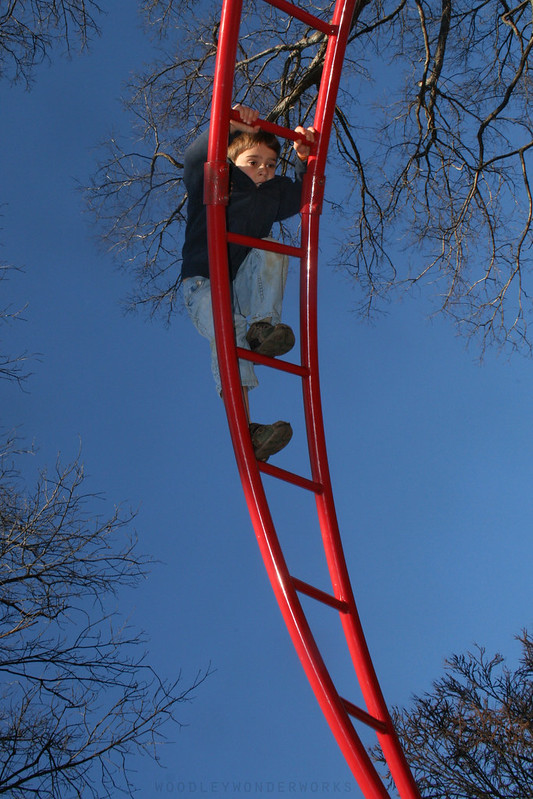Archive for the ‘Top Line Growth’ Category
Run toward the action!
 Companies have control over one thing: how to allocate their resources. Companies allocate resources by deciding which projects to start, accelerate, and stop; whom to allocate to the projects; how to go about the projects; and whom to hire, invest in, and fire. That’s it.
Companies have control over one thing: how to allocate their resources. Companies allocate resources by deciding which projects to start, accelerate, and stop; whom to allocate to the projects; how to go about the projects; and whom to hire, invest in, and fire. That’s it.
Taking a broad view of project selection to include starting, accelerating, and stopping projects, as a leader, what is your role in project selection, or, at a grander scale, initiative selection? When was the last time you initiated a disruptive yet heretical new project from scratch? When was the last time you advocated for incremental funding to accelerate a floundering yet revolutionary project? When was the last time you stopped a tired project that should have been put to rest last year? And because the projects are the only thing that generates revenue for your company, how do you feel about all that?
Without your active advocacy and direct involvement, it’s likely the disruptive project won’t see the light of day. Without you to listen to the complaints of heresy and actively disregard them, the organization will block the much-needed disruption. Without your brazen zeal, it’s likely the insufficiently-funded project won’t revolutionize anything. Without you to put your reputation on the line and decree that it’s time for a revolution, the organization will starve the project and the revolution will wither. Without your critical eye and thought-provoking questions, it’s likely the tired project will limp along for another year and suck up the much-needed resources to fund the disruptions, revolutions, and heresy.
Now, I ask you again. How do you feel about your (in)active (un)involvement with starting projects that should be started, accelerating projects that should be accelerated, and stopping projects that should be stopped?
And with regard to project staffing, when was the last time you stepped in and replaced a project manager who was over their head? Or, when was the last time you set up a recurring meeting with a project manager whose project was in trouble? Or, more significantly, when was the last time you cleared your schedule and ran toward the smoke of an important project on fire? Without your involvement, the over-their-head project manager will drown. Without your investment in a weekly meeting, the troubled project will spiral into the ground. Without your active involvement in the smoldering project, it will flame out.
As a leader, do you have your fingers on the pulse of the most important projects? Do you have the knowledge, skills, and abilities to know which projects need help? And do you have the chops to step in and do what must be done? And how do you feel about all that?
As a leader, do you know enough about the work to provide guidance on a major course change? Do you know enough to advise the project team on a novel approach? Do you have the gumption to push back on the project team when they don’t want to listen to you? As a leader, how do you feel about that?
As a leader, you probably have direct involvement in important hiring and firing decisions. And that’s good. But, as a leader, how much of your time do you spend developing young talent? How many hours per week do you talk to them about the details of their projects and deliverables? How many hours per week do you devote to refactoring troubled projects with the young project managers? And how do you feel about that?
If you want to grow revenue, shape the projects so they generate more revenue. If you want to grow new businesses, advocate for projects that create new businesses. If you need a revolution, start revolutionary projects and protect them. And if you want to accelerate the flywheel, help your best project managers elevate their game.
“Speeding Pinscher” by PincasPhoto is licensed under CC BY 2.0
Taking vacations and holidays are the most productive things you can do.
 It’s not a vacation unless you forget about work.
It’s not a vacation unless you forget about work.
It’s not a holiday unless you leave your phone at home.
If you must check-in at work, you’re not on vacation.
If you feel guilty that you did not check-in at work, you’re not on holiday.
If you long for work while you’re on vacation, do something more interesting on vacation.
If you wish you were at work, you get no credit for taking a holiday.
If people know you won’t return their calls, they know you are on vacation.
If people would rather make a decision than call you, they know you’re on holiday.
If you check your voicemail, you’re not on vacation.
If you check your email, you’re not on holiday.
If your company asks you to check-in, they don’t understand vacation.
If people at your company invite you to a meeting, they don’t understand holiday.
Vacation is productive in that you return to work and you are more productive.
Holiday is not wasteful because when you return to work you don’t waste time.
Vacation is profitable because when you return you make fewer mistakes.
Holiday is skillful because when you return your skills are dialed in.
Vacation is useful because when you return you are useful.
Holiday is fun because when you return you bring fun to your work.
If you skip your vacation, you cannot give your best to your company and to yourself.
If neglect your holiday, you neglect your responsibility to do your best work.
Don’t skip your vacation and don’t neglect your holiday. Both are bad for business and for you.
“CatchingButterflies on Vacation” by OakleyOriginals is licensed under CC BY 2.0
Certainty or novelty – it’s your choice.
 When you follow the best practice, by definition your work is not new. New work is never done the same way twice. That’s why it’s called new.
When you follow the best practice, by definition your work is not new. New work is never done the same way twice. That’s why it’s called new.
Best practices are for old work. Usually, it’s work that was successful last time. But just as you can never step into the same stream twice, when you repeat a successful recipe it’s not the same recipe. Almost everything is different from last time. The economy is different, the competitors are different, the customers are in a different phase of their lives, the political climate is different, interest rates are different, laws are different, tariffs are different, the technology is different, and the people doing the work are different. Just because work was successful last time doesn’t mean that the old work done in a new context will be successful next time. The most important property of old work is the certainty that it will run out of gas.
When someone asks you to follow the best practice, they prioritize certainty over novelty. And because the context is different, that certainty is misplaced.
We have a funny relationship with certainty. At every turn, we try to increase certainty by doing what we did last time. But the only thing certain with that strategy is that it will run out of gas. Yet, frantically waving the flag of certainty, we continue to double down on what we did last time. When we demand certainty, we demand old work. As a company, you can have too much “certainty.”
When you flog the teams because they have too much uncertainty, you flog out all the novelty.
What if you start the design review with the question “What’s novel about this project?” And when the team says there’s nothing novel, what if you say “Well, go back to the drawing board and come back with some novelty.”? If you seek out novelty instead of squelching it, you’ll get more novelty. That’s a rule, though not limited to novelty.
A bias toward best practices is a bias toward old work. And the belief underpinning those biases is the belief that the Universe is static. And the one thing the Universe doesn’t like to be called is static. The Universe prides itself on its dynamic character and unpredictable nature. And the Universe isn’t above using karma to punish those who call it names.
“Stonecold certainty” by philwirks is licensed under CC BY-ND 2.0
When your company looks in the mirror, what does it see?
 There are many types of companies, and it can be difficult to categorize them. And even within the company itself, there is disagreement about the company’s character. And one of the main sources of disagreement is born from our desire to classify our company as the type we want it to be rather than as the type that it is.
There are many types of companies, and it can be difficult to categorize them. And even within the company itself, there is disagreement about the company’s character. And one of the main sources of disagreement is born from our desire to classify our company as the type we want it to be rather than as the type that it is.
Here’s a process that may bring consensus to your company.
For all the people on the payroll, assign a job type and tally them up for the various types. If most of your people work in finance, you work for a finance company. If most work in manufacturing, you work for a manufacturing company. The same goes for sales, engineering, customer service, consulting. Write your answer here __________.
For all the company’s profits, assign a type and roll up the totals. If most of the profit is generated through the sale of services, you work for a service company. If most of the profit is generated by the sale of software, you work for a software company. If hardware generates profits, you work for a hardware company. If licensing of technology generates profits, you work at a technology company. Which one fits your company best? Write your answer here _________.
For all the people on the payroll, decide if they work to extend and defend the core offerings (the things that you sell today) or create new offerings in new markets that are sold to new customers. If most of the people work on the core offerings, you work for a low-growth company. If most of the people work to create new offerings (non-core), you work for a high-growth company. Which fits you best – extend and defined the core / low-growth or new offerings / high growth? Write your answer here __________ / ___________.
Now, circle your answers below.
We are a (finance, manufacturing, sales, engineering, customer service, consulting) company that generates most of its profits through the sale of (services, hardware, software, technology). And because most of our people work to (extend and defend the core, create new offerings), we are a (low, high) growth company.
To learn what type of company you work for, read the sentences out loud.
“Grace – Mirror” by phil41dean is licensed under CC BY 2.0
What should we do next?
 Anonymous: What do you think we should do next?
Anonymous: What do you think we should do next?
Me: It depends. How did you get here?
Anonymous: Well, we’ve had great success improving on what we did last time.
Me: Well, then you’ll likely do that again.
Anonymous: Do you think we’ll be successful this time?
Me: It depends. If the performance/goodness has been flat over your last offerings, then no. When performance has been constant over the last several offerings it means your technology is mature and it’s time for a new one. Has performance been flat over the years?
Anon: Yes, but we’ve been successful with our tried-and-true recipe and the idea of creating a new technology is risky.
Me: All things have a half-life, including successful business models and long-in-the-tooth technologies, and your success has blinded you to the fact that yours are on life support. Developing a new technology isn’t risky. What’s risk is grasping tightly to a business model that’s out of gas.
Anon: That’s harsh.
Me: I prefer “truthful.”
Anon: So, we should start from scratch and create something altogether new?
Me: Heavens no. That would be a disaster. Figure out which elements are blocking new functionality and reinvent those. Hint: look for the system elements that haven’t changed in a dog’s age and that are shared by all your competitors.
Anon: So, I only have to reinvent several elements?
Me: Yes, but probably fewer than several. Probably just one.
Anon: What if we don’t do that?
Me: Over the next five years, you’ll be successful. And then in year six, the wheels will fall off.
Anon: Are you sure?
Me: No, they could fall off sooner.
Anon: How do you know it will go down like that?
Me: I’ve studied systems and technologies for more than three decades and I’ve made a lot of mistakes. Have you heard of The Voice of Technology?
Anon: No.
Me: Well, take a bite of this – The Voice of Technology. Kevin Kelly has talked about this stuff at great length. Have you read him?
Anon: No.
Me: Here’s a beauty from Kevin – What Technology Wants. How about S-curves?
Anon: Nope.
Me: Here’s a little primer – Beyond Dead Reckoning. How about Technology Forecasting?
Anon: Hmm. I don’t think so.
Me: Here’s something from Victor Fey, my teacher. He worked with Altshuller, the creator of TRIZ – Guided Technology Evolution. I’ve used this method to predict several industry-changing technologies.
Anon: Yikes! There’s a lot here. I’m overwhelmed.
Me: That’s good! Overwhelmed is a sign you realize there’s a lot you don’t know. You could be ready to become a student of the game.
Anon: But where do I start?
Me: I’d start Wardley Maps for situation analysis and LEANSTACK to figure out if customers will pay for your new offering.
Anon: With those two I’m good to go?
Me: Hell no!
Anon: What do you mean?
Me: There’s a whole body of work to learn about. Then you’ve got to build the organization, create the right mindset, select the right projects, train on the right tools, and run the projects.
Anon: That sounds like a lot of work.
Me: Well, you can always do what you did last time. END.
“he went that way matey” by jim.gifford is licensed under CC BY-SA 2.0
The Dark Underbelly of Success
 Best practice – a tired recipe you recycle because you think the world is static.
Best practice – a tired recipe you recycle because you think the world is static.
Emergent practice – a new way to work created from whole cloth because the context is new.
Worst practice – a best practice applied to a world that has changed around you.
Novel practice– work that recognizes the world is a different place but is dismissed out-of-hand because everyone wants to live in the comfortable past.
Continuous improvement – when you try to put a shine on a tired, old process that worked ten years ago.
Discontinuous improvement – work that is disrespectful to the Status Quo and hurts people’s feelings.
Grow the core – when you do what you did in 2010 because you don’t know what else to do.
Obsolete your best work – when you do work that makes it clear to your customers that they should not have purchased your most successful product.
Reduce operating expense – what you do when you don’t know how to grow the top line and want to eliminate the flexibility to respond to an uncertain future.
Grow the top line – when you launch a new product that causes your customers to happily throw away the product they just bought from you.
A PowerPoint slide deck that defines your strategic plan – an electronic work product that distracts you from the reality of an ever-changing future.
A new product that is radically better than your last one – what you should create instead of a PowerPoint slide deck that defines your strategic plan.
MBA – a university degree that gives you a pedigree so companies hire you.
Ph.D. – a university degree that teaches you to learn, but takes too long.
Return On Investment (ROI) – a calculation that scuttles new work that would reinvent your business.
Imagination – thinking that will help you navigate an uncertain future, but is knee-capped by the ROI calculation.
Standard work – a process you used last time and will use next time because, again, you think the world is static.
Judgment – thinking that creates a whole new business trajectory to address an uncertain future but can get you fired if you use it.
A sustainable competitive advantage – a relic of a slow-moving world.
Continual change – the only way to deal with an ever-accelerating future.
Success – profits from work done by people who retired from your company some time ago.
Success – the thing that blocks you from working on the unproven.
Success – what pays the bills.
Success – what jeopardizes your ability to pay the bills in five years.
Success – why people think old practices are best practices.
Success – why new work is so difficult to do.
Success – why continuous improvement carries the day.
Success – why discontinuous improvement threatens.
Success – the mother of complacency.
“dark underbelly” by JoeBenjamin is licensed under CC BY-NC 2.0
When is it innovation theater?
 When you go to the cinema or the playhouse you go you see a show. The show may be funny, it may be sad, it may be thought-provoking, it may be beautiful, and it may take your mind off your problems for a couple of hours; but it’s not real. Sure, the storyline is good, but it came from someone’s imagination. And because it’s a story, it doesn’t have to bound by reality. Sure, the choreography is catchy, but it’s designed for effect. Yes, the cinematography paints a good picture, but it’s contrived. And, yes, the actors are good, but they’re actors. What you see isn’t real. What you see is theater.
When you go to the cinema or the playhouse you go you see a show. The show may be funny, it may be sad, it may be thought-provoking, it may be beautiful, and it may take your mind off your problems for a couple of hours; but it’s not real. Sure, the storyline is good, but it came from someone’s imagination. And because it’s a story, it doesn’t have to bound by reality. Sure, the choreography is catchy, but it’s designed for effect. Yes, the cinematography paints a good picture, but it’s contrived. And, yes, the actors are good, but they’re actors. What you see isn’t real. What you see is theater.
If you are asked to focus on the innovation process, that’s theater. Innovation doesn’t care about process; it cares about delivering novel customer value. The process isn’t most important, the output is. When there’s an extreme focus on the process that usually means an extreme focus on the output of the process would be embarrassing.
If you are tasked to calculate the net present value of the project hopper, that’s theater. With innovation, there’s no partial credit for projects you’re not working on. None. The value of the projects in the hopper is zero. The song about the value of the project hopper is nothing more than a catchy melody performed to make sure the audience doesn’t ask about the feeble collection of projects you are working on. And, assigning a value to the stagnant project hopper is a creative storyline crafted to hide the fact you have too many projects you’re not working on.
If you are asked to create high-level metrics and fancy pie charts, that’s innovation theater. Process metrics and pie charts don’t pay the bills. Here’s innovation’s script for paying the bills: complete amazing projects, launch amazing products, and sell a boatload. Full stop. If your innovation script is different than that, ball it up and throw it away along with its producer.
If the lame projects aren’t stopped so better ones can start, if people aren’t moved off stale projects onto amazing ones, if the same old teams are charged with the innovation mandate, if new leaders aren’t added, if the teams are measured just like last year, that’s innovation theater. How many mundane projects have you stopped? How many amazing projects have you started? How many new leaders have you added? How many new teams have you formed? How will you measure your teams differently? How do you feel about all that?
If a return on investment (ROI) calculation is the gating criterion before starting an amazing project, that’s innovation theater. Projects that could create a new product family with a fundamentally different value proposition for a whole new customer segment cannot be assigned an ROI because no one has experience in this new domain. Any ROI will be a guess and that’s why innovation is governed by judgment and not ROI. Innovation is unpredictable which makes an ROI is impossible to predict. And if your innovation process squeezes judgment out of the storyline, that’s a tell-tale sign of innovation theater.
If the specifications are fixed, the resources are fixed, and the completion date is fixed, that’s innovation theater. Since it can be innovation only when there’s novelty, and since novelty comes with uncertainty, without flexibility in specs, resources, or time, it’s innovation theater.
If the work doesn’t require trust, it’s innovation theater. If trust is not required it’s because the work has been done before, and if that’s the case, it’s not innovation.
If you know it will work, it’s innovation theater. Innovation and certainty cannot coexist.
If a steering team is involved, it’s innovation theater. Consensus cannot spawn innovation.
If more than one person in charge, it’s innovation theater. With innovation, there’s no place for compromise.
And what to do when you realize you’re playing a part in your company’s innovation theater? Well, I’ll save that for another time.
“Large clay theatrical mask, Romisch-Germanisches Museum, Cologne” by Following Hadrian is licensed under CC BY-SA 2.0
Goals, goals, goals.
 All goals are arbitrary, but some are more arbitrary than others.
All goals are arbitrary, but some are more arbitrary than others.
When your company treats goals like they’re not arbitrary, welcome to the US industrial complex.
What happens if you meet your year-end goals in June? Can you take off the rest of the year?
What happens if at year-end you meet only your mid-year goals? Can you retroactively declare your goals unreasonable?
What happens if at the start of the year you declare your year-end goals are unreasonable? Can you really know they’re unreasonable?
You can’t know a project’s completion date before the project is defined. That’s a rule.
Why does the strategic planning process demand due dates for projects that are yet to be defined?
The ideal future state may be ideal, but it will never be real.
When the work hasn’t been done before, you can’t know when you’ll be done.
When you don’t know when the work will be done, any due date will do.
A project’s completion date should be governed by the work content, not someone’s year-end bonus.
Resources and progress are joined at the hip. You can’t have one without the other.
If you are responsible for the work, you should be responsible for setting the completion date.
Goals are real, but they’re not really real.
“Arbitrary limitations II” by Marcin Wichary is licensed under CC BY 2.0
How to Know if Your Idea is Novel
 When your idea is novel, no one will steal it. No NDA required.
When your idea is novel, no one will steal it. No NDA required.
If your idea is truly novel, no one will value it. And that’s how you’ll know it’s novel.
When your idea is novel, no one will adopt it. This isn’t much of a stretch as, due to not-invented-here (NIH), no one will adopt anyone else’s idea – novel or not.
When your idea is novel, it will be misunderstood, even by you.
When your idea is novel, it will evolve into something else and then something else. And then it might be ready for Prime Time.
Novel ideas are like orchids – they need love beyond the worth of their blossom.
If your idea hasn’t failed three times, it’s not worth a damn.
The gestation period for novel ideas is long; if it comes together quickly, it’s not novel.
The best way to understand your novel idea is to make a prototype. And then another one.
Your first novel idea won’t work, but it will inform the next iteration. And that one won’t work either, and the cycle continues. But that’s how it goes with novel ideas.
If everyone likes your novel idea, it isn’t novel.
If no one likes your novel idea, you may be on to something.
If you’re not misunderstood, you’re doing it wrong.
If your dog likes your idea, you can’t say much because he loves you unconditionally and will always tell you what you want to hear.
If you think your novel idea will create a whole new product line in two years, your timeline is off by a factor of three, or five.
If your most successful business unit tries to squash your novel idea it’s because it threatens them. Stomp on the accelerator.
When you are known to give air cover to novel ideas, the best people want to work for you.
“it seemed like a good idea at the time” by woodleywonderworks is licensed under CC BY 2.0
Technical Risk, Market Risk, and Emotional Risk
Technical risk – Will it work?
Market risk – Will they buy it?
Emotional risk – Will people laugh at your crazy idea?
Technical risk – Test it in the lab.
Market risk – Test it with the customer.
Emotional risk – Try it with a friend.
Technical risk – Define the right test.
Market risk – Define the right customer.
Emotional risk – Define the right friend.
Technical risk – Define the minimum acceptable performance criteria.
Market risk – Define the minimum acceptable response from the customer.
Emotional risk – Define the minimum acceptable criticism from your friend.
Technical risk – Can you manufacture it?
Market risk – Can you sell it?
Emotional risk – Can you act on your crazy idea?
Technical risk – How sure are you that you can manufacture it?
Market risk – How sure are you that you can sell it?
Emotional risk – How sure are you that you can act on your crazy idea?
Technical risk – When the VP says it can’t be manufactured, what do you do?
Market risk – When the VP says it can’t be sold, what do you do?
Emotional risk – When the VP says your idea is too crazy, what do you do?
Technical risk – When you knew the technical risk was too high, what did you do?
Market risk – When you knew the market risk was too high, what did you do?
Emotional risk – When you knew someone’s emotional risk was going to be too high, what did you do?
Technical risk – Can you teach others to reduce technical risk? How about increasing it?
Market risk – Can you teach others to reduce technical risk? How about increasing it?
Emotional risk – Can you teach others to reduce emotional risk? How about increasing it?
Technical risk – What does it look like when technical risk is too low? And the consequences?
Market risk – What does it look like when technical risk is too low? And the consequences?
Emotional risk – What does it look like when emotional risk is too low? And the consequences?
We are most aware of technical risk and spend most of our time trying to reduce it. We have the mindset and toolset to reduce it. We know how to do it. But we were not taught to recognize when technical risk is too low. And if we do recognize it’s too low, we don’t know how to articulate the negative consequences. With all this said, market risk is far more dangerous.
We’re unfamiliar with the toolset and mindset to reduce market risk. Where we can change the design, run the test, and reduce technical risk, market risk is not like that. It’s difficult to understand what drives the customers’ buying decision and it’s difficult to directly (and quickly) change their buying decision. In short, it’s difficult to know what to change so they make a different buying decision. And if they don’t buy, you don’t sell. And that’s a big problem. With that said, emotional risk is far more debilitating.
When a culture creates high emotional risk, people keep their best ideas to themselves. They don’t want to be laughed at or ridiculed, so their best ideas don’t see the light of day. The result is a collection of wonderful ideas known only to the underground Trust Network. A culture that creates high emotional risk has insufficient technical and market risk because everyone is afraid of the consequences of doing something new and different. The result – the company with high emotional risk follows the same old script and does what it did last time. And this works well, right up until it doesn’t.
Here’s a three-pronged approach that may help.
- Continue to reduce technical risk.
- Learn to reduce market risk early in a project.
- And behave in a way that reduces emotional risk so you’ll have the opportunity to reduce technical and market risk.
Image credit — Shan Sheehan
Sometimes too much is just that – too much.
 When your best isn’t good enough, how do you feel? When your best isn’t good enough, what do you do? But more importantly, when your best isn’t good enough, what does that say about you?
When your best isn’t good enough, how do you feel? When your best isn’t good enough, what do you do? But more importantly, when your best isn’t good enough, what does that say about you?
If your best used to be good enough and now it isn’t, there are four possible explanations. 1.) Expectations increased and your performance is unchanged. 2.) Expectations increased and your performance increased less. 3.) Expectations increased and your performance decreased.
If expectations of your performance haven’t increased over last year, I want to work where you work because your company is an oasis (and an aberration). Since nearly all industries and occupations are governed by the unnatural mindset of growth-year-on-year-no-matter-what, it’s highly likely your performance expectations have increased. There’s no need to review this scenario.
In scenario one, your performance is unchanged. Why? Well, you may have tried to increase your performance but issues unrelated to work have consumed huge amounts of your emotional energy, and this new drain on your emotional energy consumed the energy you needed to increase your performance. A list of such issues includes global warming, deforestation, plastic in our water supply, COVID, political unrest, and the regular issues such as medical care for aging parents, death of your parents, inevitable health issues related to your aging. What does that say about you?
In scenario two, your performance increased, but the increase was insufficient. Maybe your performance would have increased quite a bit, but the special cause issues (COVID, etc.) along with the common cause issues (you and your parents get older every year) impacted your performance in a way that lessened the increase in your performance. Without the special causes, you would have met the increased expectations, but because of them, you did not. What does that say about you?
In scenario three, even though expectations increased, your performance decreased. In this case, it could be that political unrest and the other special causes teamed up with the common causes (stress of everyday life) to reduce your performance. What does that say about you?
In thermodynamics, there’s a law whose implications make it certain that there’s a limit to the amount of matter (stuff) you can put in a control volume (a defined volume that has a limit). That means that if every year you add air to a balloon, eventually it pops. Even the strongest ones. And when you extend this notion to people, it says that no matter how much pressure you apply to people, there’s a limit to what they can achieve. And if you apply pressure that overcomes their physical limit, they pop. Even the strongest ones. Or, maybe, especially the strongest ones because they try to take on more than their share.
People have a physical limit, and people cannot indefinitely support a mindset of growth-every-year-no-matter-what. No matter what, people will pop. It’s not if, it’s when. And add in the special causes of COVID, political unrest, and environmental problems and people pop sooner and cannot do what they did last year, no matter what.
And what does all this say about you? It says you are trying harder than ever. It says you are strong. It says you are amazing.
And what does it say about growth-every-year-no-matter-what? It says we should stop with all that, at least for a while.
Image credit — Judy Schmidt

 Mike Shipulski
Mike Shipulski